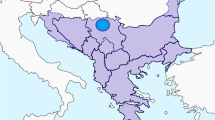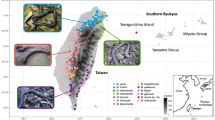Abstract
The analysis presents earthworm distribution in eight designated tectonic units (C—Cyprus, EP—East Pondites, ET—East Taurus block, Sc—Sakarya continent, Kb—Kırşehir block, L—the Levant, TM—Taurus–Menderes block, WP—West Pondites) in the East Mediterranean region (EM). It represents a full list of earthworm species (N = 81) of the region and reveals significant faunal similarities between Sc + WP, and between Kb + TM. The new Sc + WP unit is characterized by the presence of archaic (Spermophorodrilus) as well as modern earthworm fauna. In contrast, the second newly established Kb + TM unit is characterized by poorly presented earthworm autochthonous fauna and by a lack of endemic species. The analysis done on the species list (N = 73) representing the autochthonous family Lumbricidae showed statistically supported separation of L and EP between themselves and from other designated units. The Levant, part of the Arabian tectonic plate, is characterized by a high level of endemism in ancient (Healyella) and modern (Dendrobaena, Perelia) genera, and by the lack of archaic genera. The EP harbors unique species representing archaic (Eophila), ancient (Healyella), and modern (Allolobophora, Aporrectodea, Dendrobaena and Eisenia) earthworm genera in the EM. The analysis also indicates origin of earthworm fauna in TM and faunistic relationships among the designated units. Clearly, the present-day division of the EM earthworm fauna shows recognizable influences of tectonic history.



Similar content being viewed by others
References
Csuzdi Cs, Zicsi A, Mısırlıoğlu M (2006) An annotated checklist of the earthworm fauna of Turkey (Oligochaeta: Lumbricidae). Zootaxa 1175:1–29
Csuzdi Cs, Pavlíček T, Mısırlıoğlu M (2007) Earthworms (Oligochaeta: Lumbricidae, Criodrilidae, Acanthodrilidae) of the Hatay Province, Turkey, with description of three new lumbricids. Acta zool hung 53:347–361
Csuzdi Cs, Pavlíček T, Nevo E (2008) Is Dichogaster bolaui (Michaelsen, 1891) the first domicolous earthworm species? Eur J Soil Biol 44:198–201
Fattorini S (2007) Levels of endemism are not necessarily biased by the co-presence of species with different range sizes: a case study of Vilenkin and Chikatunov’s models. J Biogeography 34:994–1007
Kosswig C (1955) Zoogeography of the Near East. Syst Zool 4:50–73
Lorenz C, Butterlin J, Cavelier C (1993) Late Rupelian Palaeoenvironments (30–28 Ma). In: Dercourt J, Ricou LE, Vrielynck B et al (eds) Atlas Tethys Palaeoenvironmental maps. Maps. BEICIP-FRANLAB, Rueil-Malmaison
Michaelsen W (1922) Die Verbreitung der Oligochäten in Lichte der Wegenerischen Theorie der Kontinentenverschiebung und andere Fragen zur Stammgeschichte und Verbreitungen dieser Tiergruppen. Verhandl Naturw Ver Hamburg 29:45–79
Mısırlıoğlu M, Pavlíček T, Csuzdi Cs (2008) Earthworm biodiversity in Turkey: an overview. In: Pavlíček T, Cardet P (eds) Advances in Earthworm Taxonomy III (Annelida: Oligochaeta). En Tipis Voula Kokkinou Ltd, Nicosia, pp 139–161
Omodeo P (1952) Particolarità della zoogeographia dei lombrichi. Boll Zool 19:349–369
Omodeo P (1963) Distribution of the terricolous oligochaetes on the two shores of the Atlantic. In: Love A, Love D (eds) North Atlantic Biota and their history. Pergamon Press, New York, pp 127–151
Omodeo P (2000) Evolution and biogeography of megadriles (Annelida, Clitellata). It J Zool 67:179–201
Omodeo P, Rota E (1999) Biogeographical patterns of terricolous oligochaetes in Turkey (Annelida: Clitellata: Lumbricidae, Enchytraeidae). Biogeographia 20:61–79
Pavlíček T, Csuzdi Cs (2003) Species richness and zoogeographic affinities of earthworms in the Levant. Pedobiologia 47:452–457
Pavlíček T, Csuzdi Cs (2006) Species richness and zoogeographic affinities of earthworms in Cyprus. Eur J Soil Biol 42:111–116
Pavlíček T, Csuzdi Cs (2008) Did the autochthonous earthworm fauna emigrate from the Levant to Cyprus? In: Pavlíček T, Cardet P (eds) Advances in earthworm taxonomy III (Annelida: Oligochaeta). En Tipis Voula Kokkinou Ltd, Nicosia, pp 189–200
Pavlíček T, Csuzdi Cs, Nevo E (2006) Biodiversity of earthworms in the Levant. Isr J Ecol Evol 52:461–466
Pavlíček T, Cs Csuzdi, Koşkun Y (2009) First earthworms records in Mesopotamia (Oligochaeta). Zool Middle East 48:119–120
Şengör AMC, Yılmaz Y (1981) Tethyan evolution of Turkey: a plate tectonic approach. Tectonophysics 75:181–241
Sokal RR, Rohlf FJ (1981) Biometry, 2nd edn. W.H. Freeman and Co, San Francisco, p 858
Vilenkin B, Chikatunov VI (1998) Co-occurrence of species with various geographical ranges, and correlation between area size and number of species in geographical scale. J Biogeogr 25:275–284
Vilenkin B, Chikatunov VI, Pavlíček T (2009a) The pattern of species turnover resulting from stochastic population dynamics: the model and field data. Ecol Model 220:657–661
Vilenkin B, Chikatunov VI, Coad BW, Schileyko AA (2009b) A random process may control the number of endemic species. Biologia (Bratislava) 64:107–112
Acknowledgments
We thank Patricia Cardet (Haifa) and Robin Permut (University of Haifa) for commenting on the manuscript.
Author information
Authors and Affiliations
Corresponding author
Rights and permissions
About this article
Cite this article
Pavlíček, T., Csuzdi, C., Mısırlıoğlu, M. et al. Faunistic similarity and endemism of earthworms in east mediterranean region. Biodivers Conserv 19, 1989–2001 (2010). https://doi.org/10.1007/s10531-010-9821-1
Received:
Accepted:
Published:
Issue Date:
DOI: https://doi.org/10.1007/s10531-010-9821-1




